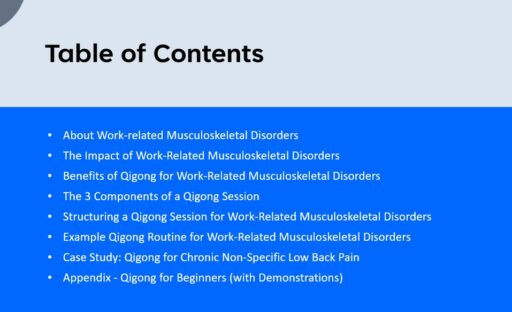In today’s fast-paced world, work-related musculoskeletal disorders (WMSDs) are increasingly common, often leading to significant pain and discomfort. These disorders typically affect the lower back, neck, upper limbs, and synovial joints. If left untreated, they can escalate, involving tendons, peripheral nerves, and joint capsules, which underscores the importance of professional and effective treatment strategies.
One such promising approach is Qigong, an ancient Chinese exercise that offers holistic benefits for physical and mental well-being. A study recently published by Journal of lifestyle medicine reveals how Qigong can be a game-changer for those suffering from WMSDs.

A tutorial with details is available for ATCQA Members and Certified Instructors/Practitioners.
Understanding Work-Related Musculoskeletal Disorders
WMSDs are characterized by pain and muscle spasms, predominantly affecting the lower back, neck, and upper limbs. These conditions are often exacerbated by prolonged periods of sitting, poor posture, and repetitive movements common in many work environments. When not treated properly, WMSDs can lead to more severe issues involving tendons, nerves, and joint capsules.
Qigong: A Comprehensive Approach for Musculoskeletal Health
Qigong, an ancient Chinese practice, integrates physical postures, breathing techniques, and mental focus. It is increasingly recognized for its benefits in managing various musculoskeletal conditions, including chronic non-specific low back pain (CNSLBP) and arthritis. Qigong not only addresses the physical aspects of pain but also enhances mental and spiritual well-being, aligning with the World Health Organization’s holistic definition of health.
Recent studies have shown that Qigong is particularly effective for managing CNSLBP, a prevalent issue among young adults who sit for extended periods. By incorporating Qigong into their routine, individuals can experience:

- Reduced Stress: Through mindful movements and breathing techniques.
- Improved Physical Function: Enhanced flexibility, strength, and range of motion.
- Mental and Spiritual Benefits: Promoting overall well-being and quality of life.
For arthritis sufferers, especially those with osteoarthritis, Qigong has been shown to:
- Reduce Pain: By improving blood flow and delivering oxygen and nutrients to affected tissues.
- Enhance Joint Mobility: Through gentle, rhythmic movements.
- Lower Dependence on Medication: By providing natural pain relief and improving physical function.
Practical Qigong Techniques for Musculoskeletal Disorders
One effective sequence for musculoskeletal health is the abdominal sequence, which includes:
- Abdominal Massage: To stimulate digestive organs and improve circulation.
- Core Muscle Stretching and Strengthening: To support the spine and improve posture.
- Breathing Control: To maximize the benefits of each movement.
Conclusion
Qigong offers a holistic approach to managing work-related musculoskeletal disorders, addressing both physical and mental aspects of health. Its gentle, yet effective movements can enhance dynamic stability, reduce pain, and improve overall quality of life. For those struggling with WMSDs, incorporating Qigong into their routine can be a transformative step towards better health and well-being.
As we continue to explore the benefits of Qigong through ongoing research, its potential to alleviate musculoskeletal pain and enhance life quality becomes increasingly evident. Embrace Qigong today and take a proactive step towards a healthier, more balanced life.